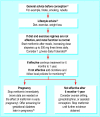Metformin in polycystic ovary syndrome: systematic review and meta-analysis
- PMID: 14576245
- PMCID: PMC259161
- DOI: 10.1136/bmj.327.7421.951
Metformin in polycystic ovary syndrome: systematic review and meta-analysis
Abstract
Objective: To assess the effectiveness of metformin in improving clinical and biochemical features of polycystic ovary syndrome.
Design: Systematic review and meta-analysis.
Data sources: Randomised controlled trials that investigated the effect of metformin compared with either placebo or no treatment, or compared with an ovulation induction agent.
Selection of studies: 13 trials were included for analysis, including 543 women with polycystic ovary syndrome that was defined by using biochemical or ultrasound evidence.
Main outcome measure: Pregnancy and ovulation rates. Secondary outcomes of clinical and biochemical features of polycystic ovary syndrome.
Results: Meta-analysis showed that metformin is effective in achieving ovulation in women with polycystic ovary syndrome, with odds ratios of 3.88 (95% confidence interval 2.25 to 6.69) for metformin compared with placebo and 4.41 (2.37 to 8.22) for metformin and clomifene compared with clomifene alone. An analysis of pregnancy rates shows a significant treatment effect for metformin and clomifene (odds ratio 4.40, 1.96 to 9.85). Metformin has an effect in reducing fasting insulin concentrations, blood pressure, and low density lipoprotein cholesterol. We found no evidence of any effect on body mass index or waist:hip ratio. Metformin was associated with a higher incidence of nausea, vomiting, and other gastrointestinal disturbance.
Conclusions: Metformin is an effective treatment for anovulation in women with polycystic ovary syndrome. Its choice as a first line agent seems justified, and there is some evidence of benefit on variables of the metabolic syndrome. No data are available regarding the safety of metformin in long term use in young women and only limited data on its safety in early pregnancy. It should be used as an adjuvant to general lifestyle improvements and not as a replacement for increased exercise and improved diet.
Figures





Comment in
-
Review: metformin used alone or combined with clomifene may improve ovulation rates in the polycystic ovary syndrome.ACP J Club. 2004 May-Jun;140(3):75. ACP J Club. 2004. PMID: 15122838 No abstract available.
References
-
- Hull MGR. Epidemiology of infertility and polycystic ovarian disease: endocrinological and demographic studies. Gyn Endocrinol 1987;1: 233-45. - PubMed
-
- Polson DW, Adams J, Wadsworth J, Franks S. Polycystic ovaries—a common finding in normal women. Lancet 1988;1: 870-2. - PubMed
-
- Michelmore KF, Balen AH, Dunger DB, Vessey MP. Polycystic ovaries and associated clinical and biochemical features in young women. Clin Endocrinol Oxf 1999;51: 779-86. - PubMed
-
- Reaven G. Syndrome X: 10 years after. Drugs 1999;58(suppl 1): S19-82. - PubMed
-
- Legro RS. Diabetes prevalence and risk factors in polycystic ovary syndrome. Obstet Gynecol Clin North Am 2001;28: 99-109. - PubMed
Publication types
MeSH terms
Substances
LinkOut - more resources
Full Text Sources
Other Literature Sources
Medical
Research Materials
